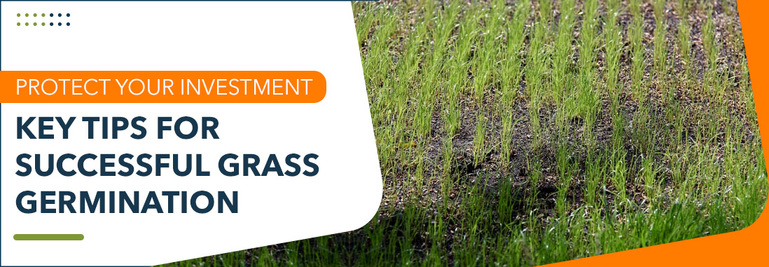How long does it take grass seed to grow?
You've got everything in place: the right grass seed, conditions, and time. A lush lawn awaits. Now you're wondering, how long does it take grass seed to grow ... how long?
The speed of the germination process depends on the grass type (more on that later). Many factors affect the process. A newly seeded lawn might fill in within six to nine weeks.
How long does it take grass seed to grow? It depends on the conditions
Soil conditions and weather help or hinder grass growth after seeding. Let's take a deeper look at these two factors.
Soil Conditions
Grass often thrives in lawns with soil where water easily reaches the root zone, and oxygen flows well; it struggles in hard soil. Aeration can help prepare the soil for seeding.
Weak soil conditions hinder grass growth. The result? Well, for those trying to answer how long grass seed takes to grow, poor soil can slow down the process, cause patchy grass growth, or keep the seeds from germinating altogether.
Grass needs warmth to grow as well.
Weather
Besides affecting the ground temperature, the weather can complicate seeding or cause the germination process to fail with events like flooding. A healthy dose of rain is great. Too much, and the hope of a new lawn might flow into a drainage ditch.
A dry spell is bad news, too. Grass seeds need water. The sun might sniff out most moisture — hindering grass growth.

Setting up a new lawn and overseeding
Whether you're attempting to repair a lawn or establish a new one, here are a few steps to take to ensure your grass seed grows within an optimal timeline:
How to overseed an existing lawn
Overseeding is seeding over an existing lawn and is used alongside aeration. It has nothing to do with spreading too much grass seed, as some might assume from the process's name.
By spreading grass seeds after you have aerated them, you give them a great space to grow.
The result is a thicker lawn that is both greener and healthier. With a healthier root system, you will see more vigorous growth, and your lawn will be more resilient to issues such as drought.
To effectively aerate and overseed, follow these steps:
Step 1: Mow your grass down lower than usual and thin the turf using a rake or other tool.
Step 2: Aerate to open up the soil and reduce compaction. Adding some starter fertilizer to the lawn is also a good idea.
Step 3: Carefully read the packaging. Spread the grass seed at the indicated rate in the instructions. Lightly rake in the seeding into the perforations made during aeration.
Step 4: Consider top-dressing your lawn after overseeding to increase the chances of success. Peat moss, mulch, or compost will do the job well.
Seeding a new lawn
Those asking how long does it take grass seed to grow are most likely starting a new lawn. The following advice below may only work well for some types of grasses. Some require specialized care and procedures. However, the following guidelines will help you have a better understanding of the process:
Step 1: Prepare the ground by tilling or digging. Usually, a three-inch depth is all that is needed.
Step 2: Kick off the process by adding starter fertilizer, topsoil, or compost into the soil.
Step 3: Plant the grass seed by spreading half of it in one direction across the entire lawn and spreading the other half perpendicular to those lines, creating a criss-cross pattern. Buy a good quality seed and spread it according to all instructions. Seedlings fail to grow when they're improperly planted or lack enough moisture.
Step 4: Rake the yard again to help cover the seeds. Those with larger yards may need to use a verticutter or power rake. The goal is to get the seed into the soil. If only applied to the surface, it may fail to germinate or do so poorly.
Use an erosion blanket or a weed-free straw to prevent the seed from washing out, blowing away, or getting picked up by birds.
Step 5: Frequently water the lawn. Newly seeded grass relies on moisture to dig its roots in. Feel the ground. Is it moist? Good. If not, water again. The early stages are critical. Don't flood the lawn; just keep the soil darkish brown. You can cut back on watering once the grass reaches about an inch tall.

Different grass types grow at different rates
Cool-Season Grasses
Cool-season grasses thrive in areas of the country like the Great Plains, the Pacific Northwest, New England, and more. They thrive in places with temperate summers and even freezing winters.
Cool-season grasses might germinate quickly. Fescues have fast germination rates and can germinate in as little as four days after planting. Perennial ryegrass isn't far behind and usually germinates within five to seven days.
Kentucky bluegrass germinates more slowly than other cool-season grasses — two to three weeks is standard.
Cold-season grasses take off best when soil temperatures reach 50 to 60 degrees. Soil thermometers are inexpensive and can eliminate the guesswork.
Warm-Season Grasses
Warm-season grass powers through hot summers and mild winters.
Warm-season grasses grow best in areas that see hot summers and milder winters. Parts of the south, southwest, and the Deep South need warm-season grasses, while parts of the nation in the transition zone face unique challenges with their lawns.
Warm-season grasses typically germinate within a week to one month.
Bahia grass grows slow: expect to wait four weeks before catching sight of activity. Zoysia grass comes next and typically takes two to three weeks to germinate. St. Augustine and Centipede grasses come in about a week or two.
The best time to plant warm-season grasses is late spring and early summer when soil temperatures reach about 70 degrees or more.
Tips for seeding success

You've spent a pretty penny on seeding your lawn. The last thing you want is to jeopardize your chance of germination and success. Let's take a look at what you should do to help your lawn grow fully, healthy, and strong:
Tilling might rejuvenate dormant weeds. A renewed exposure to light and water encourages their growth. Hand-pull weeds that crop up. Herbicides harm seedlings. Wait at least 30 days before using herbicides.
Limit foot traffic. The newly planted grass remains fragile for at least a month or until after three or four mows.
Once the turf reaches about three inches tall throughout 70 to 80 percent of the lawn, it's good to mow in most cases. Usually, it takes about three to four weeks before it's ready to mow. Utilize proper mowing techniques: mow higher to avoid cutting too low and stressing the grass, make sure your blades are sharp, and mow every week. If that's difficult, go ahead and sign up to get your yard cut by a professional.
Water the lawn consistently, but don't overdo it.
Quick Summary

Aspect |
Details |
|
|
6 to 9 weeks |
|
Key Factors |
Soil conditions, weather |
|
Preparation Steps |
Aerate soil, add starter fertilizer, spread seed, rake, water frequently |
|
Cool-Season Grasses |
Fescues: 4 days Perennial ryegrass: 5-7 days Kentucky bluegrass: 2-3 weeks |
|
Warm-Season Grasses |
Bahia grass: 4 weeks Zoysia grass: 2-3 weeks St. Augustine/Centipede: 1-2 weeks |
Those wondering how long it takes grass seed to grow must have an understanding of the grass types and conditions that affect how well seeds germinate. There are several steps homeowners can take when establishing or rejuvenating their lawns. Proper watering, mowing, and limiting foot traffic affect the success of grass seeding.
Cool-season grasses like Fescues might germinate as soon as four days, while the warm-season Bahia grass takes about four weeks to germinate.





 Share
Share











